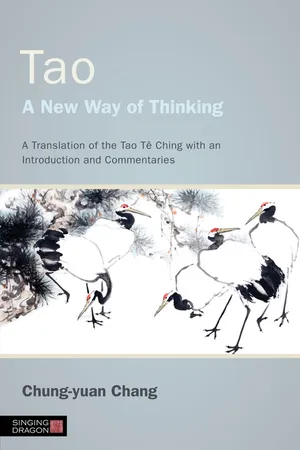![]()
Tao
A New Way of Thinking
![]()
Chapter 1
The Tao that can be spoken of is not the Tao itself.
The name that can be given is not the name itself.
The unnameable is the source of the universe.
The nameable is the originator of all things.
Therefore, oftentimes without intention I see the wonder of Tao.
Oftentimes with intention I see its manifestations.
Its wonder and its manifestations are one and the same.
Since their emergence, they have been called by different names.
Their identity is called the mystery.
From mystery to further mystery:
The entry of all wonders!
Commentary
This chapter both introduces and summarizes the entire Tao Tê Ching. The “five thousand words” of the text are all based on this chapter. It contains a number of basic ideas which help to reveal the essence of Tao. Tao is conceived of as the source of the universe and the originator of all things. Tao cannot be determined: it is nameless and inexpressible. Further, its wonder and its manifestations, its reality and its appearance are identified. The approach to this identity is through non-intention, or “non-willing.”1
As mentioned in the introduction, Tao has been identified in the past as reason or nature, eternal or absolute. These names are all one-sided and misleading. Therefore, in this translation Tao is called “the Tao itself.” This means that it is the real Tao whose hidden meaning is revealed through non-discrimination. The real Tao is also used in the commentary by the great Buddhist Te-ching (1546–1623). As he says:
The Tao that is explained here is the genuine, real Tao (chen ch’ang chih Tao) which is free from form, free from names, and cannot be expressed by words. What can be explained or named is not the genuine, real Tao. Even the word Tao itself is not a real name.2
In Heidegger’s work we read:
The key word in Laotse’s poetic thinking is Tao, which “properly speaking” means way. But because we are prone to think of “way” superficially, as a stretch connecting two places, our word “way” has all too rashly been considered unfit to name what Tao says. Tao is then translated as reason, mind, raison, meaning, logos…
Perhaps the mystery of mysteries of thoughtful Saying conceals itself in the words “way,” Tao, if only we will let these names return to what they leave unspoken, if only we are capable of this, to allow them to do so.3
“The mystery of mysteries” might be seen through the eyes of Buddhism: that is, the Dharma Eye, which sees differentiation; the Wisdom Eye, which sees non-differentiation; and the Buddha Eye, which sees both differentiation and non-differentiation. Through the Dharma Eye one sees the manifestations of Tao in ten thousand things. Through the Wisdom Eye one sees the wonder of Tao. Through the Buddha Eye one sees the identity of the manifestations and the wonder of Tao. Thus, the three eyes lead one through the gate of all the wonders of Tao. Hence, in the line “oftentimes without intention I see the wonder of Tao,” the word “see,” or “kuan,” is the key to the treasure of Tao. However, kuan is not the ordinary seeing of either the nameable or the unnameable, being or non-being. This seeing is one-sided: that is, when one sees the nameable, one neglects the unnameable; when one sees the unnameable, one neglects the nameable. The real action of kuan is seeing that the unnameable and the nameable are identified. Thus, when one sees nothing, one does not simply see nothing. One sees that within nothing, ten thousand things are simultaneously concealed and unconcealed. When one sees being, one is not limited to the form of being. One sees that being is simultaneously the formlessness of being and the wonder of non-being. Therefore, Lao Tzu says:
Its wonder and its manifestations are one and the same…
Their identity is called the mystery.
The action of kuan is the mental function of contemplation. Through this contemplation, one immediately grasps the complete identity of the nameable and the unnameable, or being and nothing. What is seen in this chapter cannot be conceptualized. Originally, yu and wu were read together with yü, as yu yü, or intention, and wu yü, or non-intention. Then, in the eleventh century, the Chinese commentator Su Ch’ê used being and non-being as objects of kuan. He read yu and wu separately from yü, as being and non-being; he read yü as the verb “to wish.” The ideas of intention, or yu yü, and non-intention, or wu yü, were discarded. Su Ch’ê did not understand that through wu yü, or without intention or non-willing, one is freed from conceptualization and released to the total identity of the seer and the seen, which is the highest stage of the mystery of Tao. Without this inner experience of identity, everything that has been said here would merely be the “rubbish” of conceptua...
